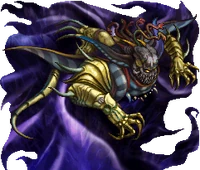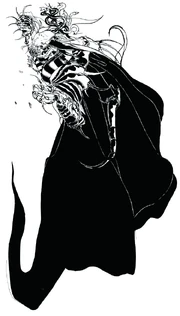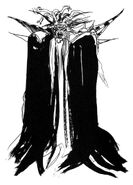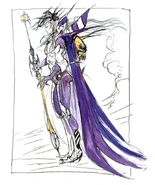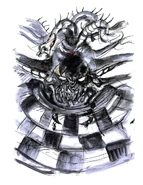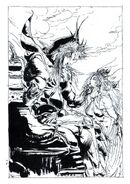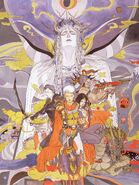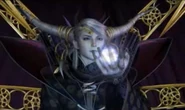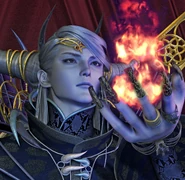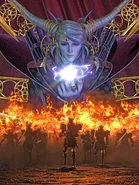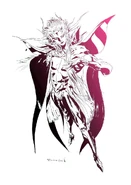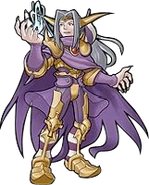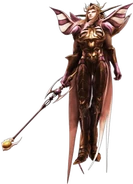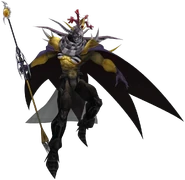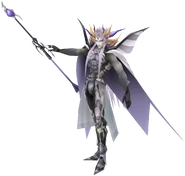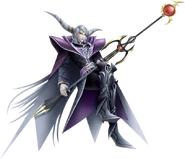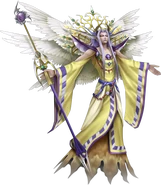Template:Sideicon
You have braved the bowels of Hell to reach me. But the hand of man, which deals in false justice and forsaken love, can never hope to defeat the lord master of Hell!
The Emperor
The Emperor of Palamecia is the main antagonist of Final Fantasy II. He is the ruler of the Palamecian Empire and aims to conquer the world through demonic forces. Though known simply as the Emperor in Final Fantasy II, he is named Mateus (マティウス, Matiusu?) in the Japan-exclusive novelization: Final Fantasy II Nightmare's Labyrinth by Kenji Terada. His name, Mateus, is referred to in Dissidia Final Fantasy with his best weapon, Mateus's Malice. He is known as Empire in the Dark Shadow Over Palakia translation.
Profile
Appearance
The Emperor wears golden armor with purple and rose-colored robes over the shoulder armor. The robes have four portions, two connected on each side, and a raised collar and extended striped "shoulders". His hair is blond (although the exact shade varied, with some artworks having it appear golden blond and other artworks and to a certain degree his sprites depicting it as platinum blond) and spiked, with an extra-long ponytail, and purple ombre at the tip of the side bangs. His head is adorned with tiny colored jewels. He has four long golden purple-tipped spikes atop his head implied in the Dissidia series to be part of his crown (they have a metallic luster in Dissidia NT). Black and white stripes trace his ribs on his chestplate, and demonic looking faces embellish his waist and back. His gauntlets sport extended claws. The Emperor wears purple makeup on his eyes and lips, and a purple and gold crown depicting a serpent. His boots' heels resemble stiletto heels. He wears a transparent quartz-colored cloth belt around his waist.
He has at times worn a darker outfit, consisting of navy blue robes with yellow octastar arrangements. It has curved spines near the shoulders and back, spined fasteners at the front, and four massive curved purple shoulder ornaments. He wears gauntlets resembling spiders, and his platinum-colored hair is styled to resemble a pair of demonic horns. This outfit exposes his hands, which have long fingernails painted black with golden lines, and rings on his middle and index fingers of his left hand. The pair of horns has golden ornaments and a crown with rubies. The Dissidia 012 version of this outfit is largely similar, although the shoulder ornaments are toned down to simply resemble a cloak mantle. The Emperor has gray and black shin armor and a belt stylized in a similar manner to the spines in the cape fastener and on his back. In Dissidia NT, his boots have heels added to the outfit.
His Dissidia appearance gives him a scepter with a circular disc with curved spikes on top of the circles as well as two prongs at the center. With the exception of his Arubboth costume, the primary colors of the staff match with the color of his armor. He was also seen wielding a similar staff in the NES/DoS versions of Final Fantasy II.
Because his soul was split to dominate both sides of the afterlife, the Emperor carries on two appearances, each representing the spiritual element the form embodies. The first half is Hell Emperor, Emperor of Hell, or simply Dark Emperor. This form is almost bestial with a skull-like face, razor-sharp teeth, and snakes on his head similar to Medusa. He is covered with spines and wears a dark cape or cloak and has clawed hands. His battle sprite in the NES/DoS and mobile/Steam versions seems to lack a lower half, although in the Dissidia subseries, as well as the PlayStation/GBA versions, he is shown to have it. In the former, he overall has a similar build to his human self, with his lower half having the armor appear darker than in the original human form. At least in the case of Violet Robes, his skin also darkens in this form. His field and battle sprites from the PlayStation version onward (and in the case of the latter, as early as the NES version) depict him with a scepter, although the PSP/iOS versions omit the staff in the battle sprite.
The other half, the Light Emperor, has an otherworldly appearance and always has his eyes closed. He has six wings similar to a Seraph, and a golden gate on his back. He at times appears to be made of clouds and wears a light-colored robe. The design may be based on Lucifer. The Light Emperor's portrait is based on Mateus's appearance from a promotional poster by Yoshitaka Amano.
by Yoshitaka Amano.
Personality
The Emperor of Palamecia is cunning, subtle, rude and arrogant. He calls Firion by name after he defeats the Emperor's Behemoth, but other times calls them insects or worms when Firion's party foils his plans. Owing to his arrogant nature, the Emperor usually never fights unless he has to, and has his minions do the work for him. His actions are tyrannical and he abhors humanity. He acting as mankind's judge, declaring humanity to have a flawed sense of justice and having forsaken love, and being inherently violent. As the Emperor views humans as interchangeable, he sees himself as superior to them and thus views himself as the only one capable of ruling. Due to these misanthropic views, he is demonstrated to be a megalomaniac. The Emperor is implied to be skilled with developing advanced weaponry, as the Dreadnought airship was implied to have been developed by him. He is described as callous in his bio in Dissidia Final Fantasy. He is skilled in strategy, as evidenced by how he left a decoy of the then-captured Princess Hilda aboard the Dreadnought, and used the real deal for the coliseum to draw out the Wild Rose rebels.
The empire? Ha! I've no need for such trifles now. All the world shall fall by my hand and the powers I gained in Hell. And your blood will be the first to spill!
Emperor Mateus, as the Dark Emperor, in response to Leon's protest against handing him back the throne upon his return
There are subtle personality differences between the Emperor's different incarnations in the mortal world and the afterlives. The Dark Half is arrogant and destructive to the point of no longer caring about merely ruling the Palamecian Empire, seeking to destroy the world with the powers he gained upon his return from Hell. The Light Half initially comes off as courteous and apologetic, but is revealed to be a hypocrite and a liar, containing the same misanthropic spirit as the Emperor.
In the novel Muma no Meikyū it is stated Palamecia is cursed with demonic influences that corrupt its emperors. The demon, desiring to rule the world by human proxy, turns men into malicious masterminds by polluting their thoughts with its malice. This is the only insight into Emperor Mateus's backstory, though it's never been supported as canon in the game.
Abilities
This world can have but one Emperor, and I am he!
The Emperor to Leon after returning from Hell
Even before he crowns himself the Emperor of Hell, Mateus is incredibly powerful, able to create cyclones destructive enough to devastate entire towns and lift one of his castles to use as a mobile fortress. He casts strong Lightning-elemental spells and uses a variety of protection spells, such as Protect, Wall, Shell, Haste and Blink. The opening FMV included in the PlayStation version of Final Fantasy II implies the Emperor can manipulate the tide of battle via energy from his fingertips, even when he isn't directly at the battlefield. He can teleport, or at least leave behind an illusion of himself, as evidenced by how he traps Firion and his party at the Coliseum.
Upon his death, and eventual rebirth, the Emperor gains the ability to summon Pandaemonium to the surface world as well as a slew of new demonic powers. His physical attacks have a drain effect, allowing him to steal lifeforce from enemies to replenish himself and heal injuries. His physical strikes sometimes poison or stun whom they strike. He still uses his Thunder spell and has gained a high level Flare attack and the original Meteor spell, Starfall. The Emperor is nigh invincible to most physical attacks unless it's against the Blood Sword or the attacker is augmented by Haste or Temper. In the novelization of Final Fantasy II, Mateus is strong enough to defeat Satan in battle, and sold his soul to him for the power to summon demons from Hell. His Dark Half was also shown to generate purple flames of what was presumably hellfire, as evidenced by his encounter with the party in Castle Palamecia where he attempted to use it to kill them. Similarly, even the mere act of returning from Hell to the living realm causes noticeable distortions, where the environment flashes with shades of purple.
His light half is possibly more powerful than his Hell counterpart, as the Heaven Emperor's Flare and Starfall attacks are stronger and he can use two new equally dangerous attacks, Holy and Blaze. It is also implied that the Hell Emperor cannot be killed so long as the Heaven counterpart exists. He can even return dead souls to their bodies, and implies that he is able to grant eternal life to people.
Story
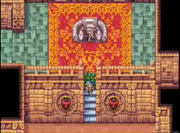
Emperor at the Coliseum.
The Emperor begins his campaign for world domination by summoning an army of creatures from Hell. Several kingdoms, like Fynn, Kashuan and Deist, resist, but are subdued. In the case of the militarily-powerful homeland of the Dragoons, Deist, the Emperor orders the poisoning of their wyverns' water supplies, leaving the Dragoons powerless.
The novelization develops on the origin of his powers, attributing it to Satan, lord of Pandaemonium, with whom Mateus makes a pact to summon demonic forces into the mortal world. In the novel Muma no Meikyū the demon that corrupts the minds of Palamecian emperors originates from the beginning of the world when it became trapped within the indestructible "Stone of Iludia" and swore revenge. After ascending to the throne, Mateus exiled his mother, Airu, to the deserts of Palamecia, and yet she still spends her life trying to find a way to save him, although she never manages to do this.
The royalty of Kashuan, which survived the Palamecian Empire's attack, founded the Wild Rose Rebellion alongside the kingdom of Fynn. The Empire attacks Fynn to destroy the resistance and after capturing it, the Emperor begins the construction of the fearsome Dreadnought.
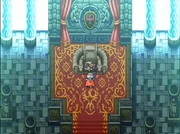
The Emperor is defeated at his Cyclone.
After Firion and the rest of the party gather the Sunfire and Princess Hilda is captured by the Dreadnought while traveling to Kashuan on Cid's airship, the Emperor replaces the captive Hilda with a Lamia Queen. After the Dreadnought is destroyed, the Imperial Lamia is taken to Altair, and later felled. The Emperor announces a tournament at the Palamecian Coliseum, and makes Hilda the prize. Firion and his comrades attempt to rescue her alongside Prince Gordon of Kashuan.
At the Coliseum, the party meets the Emperor personally for the first time. After defeating a Behemoth pit against them, Firion and his friends attempt to kill the Emperor as they approach him to take the prize, but it is a trap, and the Emperor locks the party away via the Dark Knight. Meanwhile, the Emperor continues his assault on the land above.
After the Liberation of Fynn, the Wild Rose Rebellion acquires the Ultima Tome, but by that time the Emperor has summoned a giant Cyclone and crushed the towns of Paloom, Altair, Gatrea and Poft, and is approaching Fynn. The Emperor also was present inside the Cyclone to personally oversee the intended destruction of Fynn. The party makes their way inside by summoning a wyvern, and makes another assassination attempt on the Emperor. The Emperor initially assumes they are not important enough for him to fight despite acknowledging that they revived the Wyverns of Deist he had wiped out earlier, and thus deploys several of his royal guard against them. After two units of his royal guard are wiped out, the Emperor decides he may have underestimated them, and decides to dispose of them personally, also claiming such was to be considered an honor. The Emperor is killed in the fight, and the Dark Knight Leon proclaims himself Emperor of Palamecia and takes over the Palamecian army.

The Emperor returns from Hell.
After breaking into Castle Palamecia, the party confront the Dark Knight and the Emperor appears in the hall in a new demonic form. Upon his death, Mateus had arrived in Hell and defeated Satan before proceeding to claim the throne of Pandemonium for himself. After Leon protests that he has no intention of relinquishing the title of Emperor, Mateus reveals he no longer cares about ruling the Empire, but intends to destroy the world with his new powers, starting with the surviving members of the Wild Rose Rebellion. Ricard summons the wyvern to get the party out of Palamecia while he confronts the revived Emperor, who slaughters him with ease.

Firion's party confronts the Dark Emperor at Pandemonium.
While it is unknown if the Emperor intentionally allowed for himself to be killed to arrive to Hell, as he already had power over Hell-spawn, it is likely it was his true intention all along. After killing Ricard, Mateus summons Pandaemonium to the mountains where Palamecia once stood, and resumes his world-domination campaign. The party travels through the Jade Passage and breaks into Castle Pandemonium and after defeating each and every one of the Emperor's hellish generals, Firion and his friends confront the Emperor head on. The Emperor is defeated, and fades away, although not before expressing disbelief that he could lose against the same group twice.
Soul of Rebirth
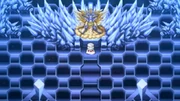
Minwu's party confronts the Light Emperor at Arubboth.
In the Dawn of Souls, 20th Anniversary and mobile platform versions, something unforeseen happens when the Emperor is killed: his soul splits in two, one going to Hell becoming the lord of Pandemonium, the other going to Heaven and becoming the lord of Arubboth. With his new powers the second Emperor summons the fallen souls of Minwu, Josef, Scott and Ricard as representatives of those who fell in the wake of the Empire's conquests.
As they reach his throne room within the walls of Arubboth, the Emperor asks for their forgiveness and offers them eternal life. They consider his offer, but the souls of the people they care about appear and tell them to look past the Emperor's charade.
The party realize they are being tricked, and that this Emperor is no different from the other. They attack the Emperor's light side while Firion's group battles his dark counterpart. The Light Emperor vows to have them know eternal suffering due to their refusal to forgive him, and as he dies, tells them the struggles of violence and war will continue as long as humans exist. He fades away just as his dark counterpart. Minwu later comments that if anyone can change man's violent legacy, it would be Firion and his friends.
Gameplay
The Emperor is fought three times in Final Fantasy II. He is first fought in human form in the Cyclone, where he fights in the company of two Royal Guards and a Wood Golem. He uses buffing magic like Haste VIII and Blink VIII, with Thunder X as his only damaging spell.
The Emperor of Hell is the game's final boss, fought in the throne room of Pandaemonium. He uses Flare XVI and Starfall X as his offensive spells, and powerful physical attacks that heal him. He uses high-level status magic like Curse XVI and Slow XVI. The Emperor of Hell is resistant to or absorbs all types of elemental damage.
The Emperor of Heaven is the final boss of Soul of Rebirth. His powers are more offensively based, using Flare XVI, Holy XVI, Blaze XVI, and Starfall XVI. His only status spell is Dispel XVI, which serves to weaken the party's resistance to his other spells.
Musical themes
Template:Listen
As of the WonderSwan Color remakes, the original boss theme of Final Fantasy II, "Battle Scene 2", is the final boss theme, while arrangements of the game's two battle themes are used for other boss battles. Thus, "Battle Scene 2" became associated with the Emperor alone as it only plays in the final battle(s) since the aforementioned version. "Battle Theme B" plays in the first boss encounter with the Emperor, shared with the Behemoth.
A rearrangement by The Black Mages titled "Battle Scene II" appears on their first studio album. Another arrangement appears on the Dissidia Final Fantasy Original Soundtrack.
Voice
In the remakes, the Emperor of Hell roars briefly before facing the party.
In the Dissidia Final Fantasy series, he is voiced in the Japanese versions by Kenyu Horiuchi.
He is voiced by Christopher Corey Smith English versions. Smith voices him with a deep, vaguely British accent with a bit of a dramatic flair, similar to the late British singer and actor David Bowie, particularly his role as Goblin King Jareth from the Jim Henson film Labyrinth (who the Emperor has some slight resemblance to).
Other appearances
Emperor Mateus has made appearances in the following games in the Final Fantasy series:
- Ivalice Alliance series as a cameo.
- Dissidia Final Fantasy as a playable character.
- Dissidia 012 Final Fantasy as a playable character.
- Dissidia Final Fantasy NT as a playable character.
- Dissidia Final Fantasy Opera Omnia as a boss.
- Pictlogica Final Fantasy as a playable character.
- Final Fantasy Artniks as a series of cards.
- Final Fantasy All the Bravest as a playable character.
- Mobius Final Fantasy as an ability card.
- Final Fantasy Trading Card Game as a series of cards.
- Final Fantasy Record Keeper as a playable character.
- Final Fantasy Brave Exvius as a summonable vision.
- Triple Triad as a card.
Non-Final Fantasy guest appearances
Emperor Mateus has made key guest appearances in the following non-Final Fantasy games:
Gallery
Etymology
Mateus is the Portuguese form of the name Matthew, which means "gift of god".
The term "emperor" is of Old French origin and was derived from "Imperator", which was the title of the Roman head of state during the Roman Republic and, post-Augustus Caesar, the Roman Empire, and itself roughly means "commander".
An emperor is a (male) monarch, usually the sovereign ruler of an empire or another type of imperial realm. Empress, the female equivalent, may indicate an emperor's wife (empress consort), mother (empress dowager), or a woman who rules in her own right (empress regnant). Emperors are generally recognized to be of a higher honor and rank than kings, and are generally the highest temporal political rank/honor in existence.
An empire is a dominion composed of a multitude of nations that's ruled by one sovereign leader, generally an emperor, although some empires were ruled by kings.
The title used for the Emperor in the Japanese version, Kōtei, is the Japanese archaic form of the title, which itself was derived from the Chinese term for Emperor, or more specifically, the Yellow Emperor.
Trivia
- By poisoning the water supply of Deist's wyverns, the Emperor was the first villain in the series to wipe out an entire kingdom. The same act would later be performed by Kefka Palazzo in Final Fantasy VI to an even grander scale, where the water supply of Doma was poisoned.
- Though the Emperor is arrogant and is not met until halfway into the game, he addresses his enemies (particularly Firion) using their names, in a somewhat non-distant manner. The identity of the Dark Knight may be relevant to this.
- The Emperor is renowned in Japan for his death-cry of "Uboaaa!" and the romanized version, "Uboar!". "Uboar" is the name of his popular Japanese fanclub. In some fan translations, this was changed to "Gwaaaahhhh!!" His death-cry is used when he loses in Dissidia, and Tidus questions him about his scream. In the English version, his death-cry was changed to "Ungaahhhh!", which has also caught on in Japan due to the English subtitle option of Final Fantasy II for the PlayStation Portable. "Uboaa" is also used in the English prototype of Final Fantasy II, Dark Shadow Over Palakia.
- The Emperor is subtly referred to in the popular web comic 8-Bit Theater. Black Mage Evilwizardington is killed by Lich and sent to Hell where he overthrows the current rulers and takes over, absorbing the powers of Hell and returning to Earth. He kills Lich and announces his plan to conquer the world, but is stripped of his powers shortly after when Lich heals the overthrown demons and becomes the new king of Hell.
- The novelization states the Emperor killed Satan to become the new Lord of Hell. Satan's name and existence is not stated explicitly in the game.
- The novelization hints at the Emperor having some lust for Hilda, but in-game there's little indication he had any feelings for her beyond using her as a tool to draw the Wild Rose rebels into the open.

